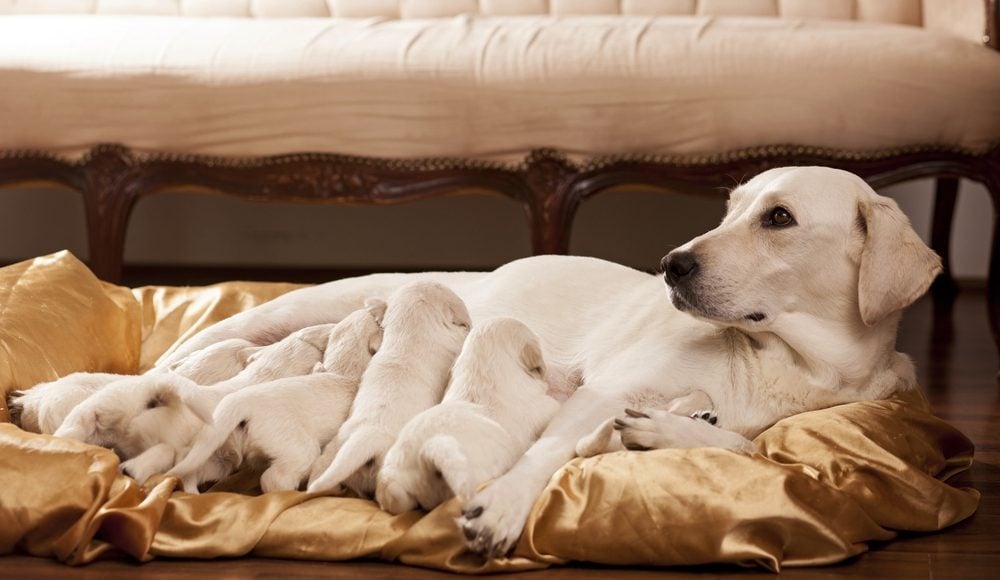Table of Contents
- 15 Tips on Dog Pregnancy
- 1. Dogs Need Prenatal Care
- 2. Prepare for Moody Mothers-to-Be
- 3. Provide Appropriate and Well-Balanced Nutrition
- 4. Keep Newborn Puppies Warm and Comfy
- 5. Think Inside the Whelping Box
- 6. Size Matters for Whelping
- 7. Know the Signs of Labor and Birth
- 8. Keep a Detailed Record
- 9. Learn to Cut the Umbilical Cord
- 10. Know How to Give the Breath of Life
- 11. Be Ready to Seek Help
- 12. Remember When Close is Too Close
- 13. Give the Right Aftercare
- 14. Whelping Puppies Need a Little Cuddling
- 15. Nature Knows Best When
- Essential Supplies for Dog Pregnancy and Whelping
- Bonus: Know What To Do If A Puppy Is Only Halfway Out of Birth Canal
You're expecting puppies; how exciting!
A dog giving birth is a beautiful experience.
Whelping is a term that covers the entire process of birthing puppies, from the first dog pregnancy stage to the dog's labor.
This usually takes around 63 days, depending on the size of the litter.
Large puppy litter may whelp three or four days early, while small litter can be several days late.
Expect to have as many as 15 puppies if the dog mom is a large breed, while small dogs might give birth to only one puppy.
The age of the dog makes a difference, too.
Knowing how long the dog will be pregnant, what you'll need during this stage and what's going to happen after is essential.
Proper preparations for before, during, and after dog pregnancy and whelping will make the process easier for everybody.
Get the whelping area ready early, and let the mom dog move in about halfway through her pregnancy to get comfortable in the new space.
In this article, we will go over how to help beginners and what you need to do to be prepared.
Follow the below tips to make the process as easy as possible for you and your pregnant dog.
15 Tips on Dog Pregnancy
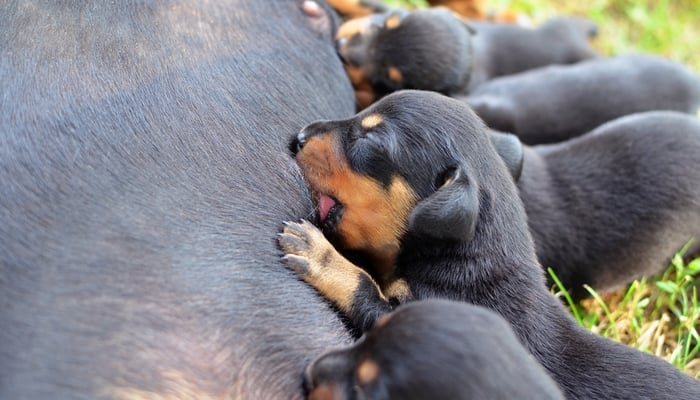
1. Dogs Need Prenatal Care
In week three, the uterus will be bed-embedded with the unborn puppies' embryos.
Around 4 weeks after mating, look for symptoms and schedule an appointment with your local veterinarian.
Your dog will show the following symptoms.
- clear vaginal discharge
- increased appetite
- showing more affection
Most likely, the vet will perform an ultrasound so you can confirm the pregnancy and know how many puppies to expect.
The veterinary healthcare team will also check for any potential health problems.
Once confirmed, you can get personalized veterinary assistance and start developing your puppy birth plan.
If your dog is long-haired, her grooming needs will change: have her back-end and tummy hair trimmed before she's due to make things easier for birth and help the puppies find her nipples.
2. Prepare for Moody Mothers-to-Be
Just like in humans, a pregnant female dog will behave differently.
Slight personality changes are very common in pregnant dogs, but it's best to keep their lives as close to their old routine as you can.
Make any changes as gradually as possible to avoid putting your pregnant dog through extra stress.
Remember, dog pregnancy can be difficult, especially if it's her first litter, so she'll need more love and care from her owner.
3. Provide Appropriate and Well-Balanced Nutrition
Well-balanced nutrition should ideally start before conception.
In most cases, you can feed a pregnant dog the same way until the last few weeks.
During the latest dog pregnancy stages, (last three or four weeks), she will need more food to prevent malnutrition and a switch to different brand, potentially.
A dog's labor can last anywhere from 4–36 hours, and your dog shouldn't be left alone at all during that time. Have everything ready to go and easily accessible.
Some of the things you'll need to have on hand during labor:
- Water for the dog to drink between births
- Some food and drinks for yourself
- Somewhere comfortable for you and your dog
- Milk substitute for the mother after giving birth and some syringes or small feeding bottles for the puppies, just in case.
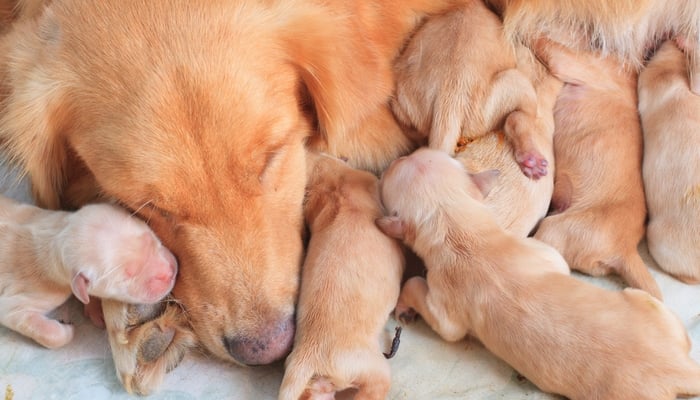
4. Keep Newborn Puppies Warm and Comfy
Just because the dog pregnancy is over doesn't mean your work is done.
Puppies cannot regulate their own body temperature for at least a week, so they will need to be kept warm, and you will need to regulate the temperature in your home.
The best room temperature for puppies during the first four days is 85 to 90 degrees Fahrenheit; this can be done by using heat lamps around the puppies' whelping box.
After the first week of the puppy's life, the temperature can be lowered to 80 degrees F.
Keep this up until puppies are about 1 month old; after that, you can go down to 72-75 degrees Fahrenheit.
Always keep heat lamps and a thermometer near the newborn puppies' place of living.
Keep unnatural light to a minimum in the first three weeks while puppies' eyes are still closed and can't see or hear.
Prepare an enclosed space where the pups can get used to light and sound gradually.
Keep a hot towel-wrapped bottle filled next to them.
Keep the warm water bottle covered so the heat doesn't hurt the newborn pups during labor.
This helps them maintain a higher body temperature since they are not developed yet to effectively maintain their own body temperature.
Have paper towels, old towels you can throw away, clean cloths or rags, and some garbage bags nearby.
5. Think Inside the Whelping Box
Good floor traction in the whelping box is essential.
Newborn puppies need safe, stable footing.
Over-flexing the legs and putting weight directly on their young hips and knees will put undue stress on the hip joints, increasing joint laxity.
Look for somewhat rough, uneven flooring.
You'll want something washable, but don't just use newspaper or sheets.
Avoid slick, plastic surfaces as well.
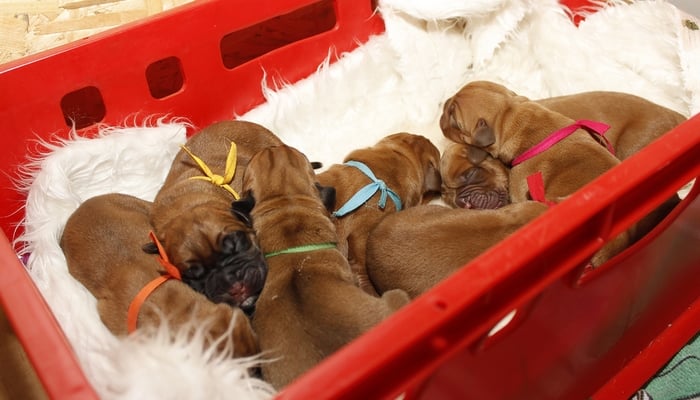
6. Size Matters for Whelping
Puppies grow quickly, but it's better to have a smaller whelping box for the first week.
This way, the puppies won't move around more than they need to.
According to a study done in 1966, this will prevent mechanical damage in undeveloped joints in puppies caused by crawling around too much before they're ready.
There are a few spots you will need to have and prepare for dog pregnancy and whelping:
- Tiny spot. This should be a smaller place for newborn puppies to rest during labor and for the first week; many dog owners use a lined laundry basket, depending on the size of the mother and the litter.
- Bigger spot. This larger place is for the pregnant dog to give birth in and for her and her puppies to move around in after the first week; you can buy special dog whelping boxes at local pet stores, but most pet owners simply use child-sized swimming pools, which are also cheaper and achieve the same goal.
- Padding. Get some rubber backed bath mats, or Sherpa pads for the floor in each of these smaller and bigger whelping spots. There are special whelping liners that you can use which achieve everything you want and are easily washable, too.
The pregnant dog whelping box also has to suit the exact size of the mother dog.
She needs to easily get in and out without landing on her puppies, which is especially important with large and inexperienced female dogs.
7. Know the Signs of Labor and Birth
Your pregnant dog may become restless and swollen or produce a small amount of discharge before giving birth.
Panting, shaking, and even vomiting are normal in these cases.
The water sack will appear first and break, followed by the first puppy.
The afterbirth can come next or with the next puppy, and you'll need a place to dispose of it.
Here are a few more things you will need to have for the dog labor stage:
- A flashlight to take with you as birth approaches – it's common for a pregnant dog to sometimes “drop a puppy” when you think she just needs to go to the bathroom.
- A rectal thermometer – get your dog used to you taking temperature. 101-102 degrees Fahrenheit (38-39 Degrees Centigrade) is normal, but if it suddenly drops to 97-99 degrees Fahrenheit (37-38 Degrees Centigrade), you'll know labor will start soon(er). Take it twice daily during the last week of pregnancy.
- A set of baby monitors – you'll need to hear when your dog goes into labor and to listen to her and her babies afterwards. You can also use a dog camera. This isn't essential but can be extremely helpful, especially for busy pet owners in a bigger house.
In most cases, you can probably buy without buying such extra supplies for whelping and birthing dogs, but having them nearby can ease the process for you and your pup.
8. Keep a Detailed Record
You must remember everything about the dog's pregnancy and labor stages because this might be medically important to show your veterinarian in case of any complications.
Record every new puppy's weight, sex, and birthing problems during and after labor.
Here are the supplies you will need near the birthing area:
- Pen and paper to write everything down
- A clock to know exactly when each puppy is born
- Scale to weigh the puppies
On top of the above, you might also want to have a (regular) camera ready to video record the birth of each puppy, and prepare numbered ribbons to tie very loosely on each puppy to make identifying them easier after the puppies are born.
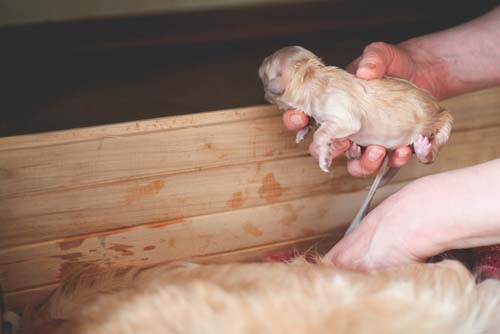
9. Learn to Cut the Umbilical Cord
Be careful not to pull off the umbilical cord because it can cause umbilical hernia.
Many dogs in labor want to bite the cord themselves, and leaving them to it is fine.
You just need to make sure that it gets done with each puppy.
For cutting the umbilical cord, you will need the following things:
- Latex gloves
- Cotton balls
- Sharp scissors for cutting the cord
- Cotton reel for tying the cord
- Antiseptic solution
- A bulb syringe, in case you need to clear fluid from a puppy's airway
Do not stress about cutting the umbilical cord – it's fairly simple.
Tie the cord two inches from the puppy and a second time another inch from there, then cut in between to prevent too much blood loss.
Clean the part still attached to the puppy with an antiseptic solution.
The rest of the cord will drop off after a few days.
10. Know How to Give the Breath of Life
You do this during the first few seconds after puppies leave their mother's womb.
Rubbing puppies with a clean, dry towel after birth gets them warm and dry and can also stimulate breathing.
It's best to read about CPR for newborns so you know how to save a puppy's life in case of any issues.
Also, look for deformities, and listen for little squeaks, checking each newborn puppy to make sure they are breathing properly.
If the puppy isn't breathing, don't panic.
Remove the water sack from a puppy's mouth and nose, then try clearing fluid from the airway with a bulb syringe.
If that doesn't work, try holding it at arm's length, upside down with its nose away from you, gently rocking it while supporting the puppy's head.
The puppy should start breathing within 15 minutes.
11. Be Ready to Seek Help
If your dog is more than three days late giving birth, or if she's been pushing for more than two hours without a puppy, take her to the veterinarian right away.
Dog pregnancy problems are common and can sometimes be fatal to both the mother and her babies, so at least call a vet if you suspect something wrong.
Be prepared ahead of time take your dog to the vet in your car if you have to by having a big cardboard box for your dog and her babies to travel in, some spare newspapers and spare blankets to keep the pregnant dog and newborn puppies warm and comfy.

12. Remember When Close is Too Close
Bonding after puppy birth between a mother and her babies is important, so give them space to let them get to know each other – do not interfere because you might get some of that maternal aggression, and simply let nature take its course.
However, if there's a problem, you'll need to move each puppy to a separate place once labor starts again, which can take minutes to hours.
Encourage each puppy to nurse to get antibodies from the colostrum, but don't worry if they're too tired to do it right away.
Try again in a few hours.
The mother will probably clean herself and each puppy, but if she's too tired and doesn't mind, you can help with cleaning using wet cloths or clean towels.
13. Give the Right Aftercare
After the last puppy is born, you can put the mother dog on a leash and take her to go to the bathroom outside.
Then, offer her more water and something to eat away from her puppies.
If she doesn't want to leave her newborn babies, try carrying one for her while keeping it warm and dry.
Next, call the vet to tell them you'll be coming over in a few hours to have everyone looked at professionally. The mother dog may get an oxytocin shot too, a special hormone that helps the dog's uterus contract and expel any leftover contents.
14. Whelping Puppies Need a Little Cuddling
Socialization of whelping puppies takes time, but it's needed to prevent behavior problems in the future.
After puppies are 3–5 weeks old, slowly get them used to normal domestic situations like household machines and other animals.
They will also need to get used to different people and to be handled regularly for a minute or two.
Just ask the guests to wash their hands first and to leave their shoes at the door.
Familiarize the puppies with being in a vehicle, too, especially a week before they move to their new homes.
15. Nature Knows Best When
Puppies need to get outside and flex their growing muscles and legs by walking on natural surfaces once they're old enough.
Prepare a safe outdoor place for them to use when they're ready, but be aware of the season.
Interestingly, spring and summer litters have fewer issues with hip displacement.
As noted above, newborn puppies may need a heat lamp or a special outdoor enclosure because they cannot regulate their body temperature and this can cause health problems.
But, if the mother is an indoor dog, she's not going to want to be separated from you with extra time outside, so don't make any changes that are too drastic.
READ NEXT: How to Tell If Your Dog Is Pregnant
Essential Supplies for Dog Pregnancy and Whelping
You've probably noticed that throughout the whole dog whelping, pregnancy, and labor stages, you may need several different things to help a dog in labor and whelping puppies and to prevent health issues.
If your dog is giving birth at home with you at her side, it may be easier to simply get a dog whelping kit for puppies with all the items you'll need.
The best one we like to use is from Little Heartbeats Whelping:

Deluxe Pro Whelping Kit 12 for Puppies Dogs
Bonus: Know What To Do If A Puppy Is Only Halfway Out of Birth Canal
This can be a scary moment, and you need to act fast.
If you can get help from another person, even better.
Here are the steps:
- Grab and use a towel or your hand to break the birth sac surrounding the puppy's head and mouth.
- Unfortunately, the Mom can stop help push the puppy out. If this is the case reach your hands in and find the puppy's shoulders.
- Once you have found them, you can apply gentle traction (pulling parallel to the mother's back legs).
- Once the baby is out, grab the umbilical cord to slowly pull out the fluid-filled sac of the placenta.
- Put the puppy near the mom and wait for her to chew the umbilical cord.
- Sit and wait until you notice the air is coming in and out of the puppy's nose.
Disclosure: We may earn affiliate commissions at no cost to you from the links on this page. This did not affect our assessment of products. Read more here and find full disclosure here.


